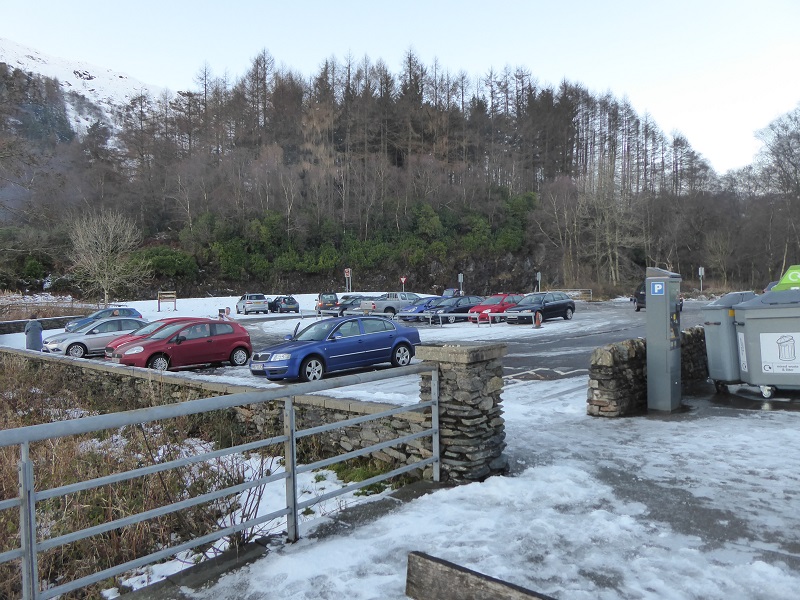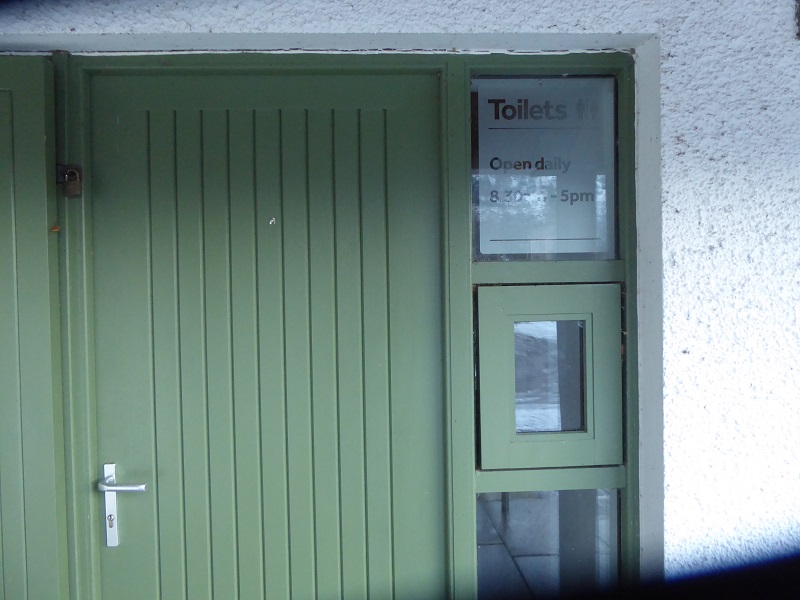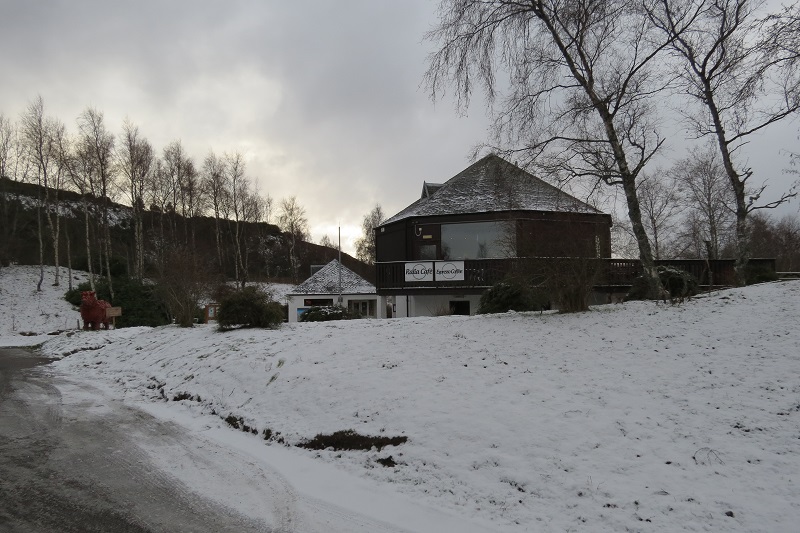
The consequences of outsourcing what used to be publicly provided services has been much in the news with the Carillion collapse. This should serve as a warning to Scotland’s Enterprise agencies operating within our National Park, with Highlands and Enterprise proposing to lend public money Cairngorm Mountain Ltd – owned by a company whose net liabilities (in December 2016) for its size appeared not dissimilar to Carillion – and with Scottish Enterprise wanting to flog off the lochshore at Balloch to Flamingo Land. Neo-liberal thinking however is so deeply embedded in the Scottish establishment that they cannot see any alternatives. It has, I believe, particularly influenced how the Loch Lomond and Trossachs National Park Authority operates and helps explain its inability to keep basic facilities open year round. This post will explain how the locked National Park toilets at Inveruglas on Saturday result from same blind adherence to neo-liberal ideology as Carillion, although obviously the consequences are very different.

In the short time I was stopped at Inveruglas I saw two parties walk up to the door only to find it locked and walk away with a shrug of the shoulders. We are being conditioned to accept basic failures in service provision but if this is to change more people need to understand what is going wrong.
When the Loch Lomond and Trossachs National Park Authority was created in 2002 some assets previously belonging to Local Authorities were transferred to it but the LLTNPA also created new facilities. Originally most of these facilities, however acquired, were operated directly but over time the LLTNPA has let some out for other purposes (e.g the former Gateway Centre at Balloch) and outsourced service provision in others. In 2013 they took this one step further with the adoption of a Commercialisation Strategy.
The ideology behind this I believe has been the same as what led to Carillion, the neo-liberal tenets that the state is bad, everything should have a price and as many services as possible should be provided by the private sector (preferably with as little supervision/interference as possible). Driving that has been the Government imposed requirement for our public authorities to make savings – budget cuts – and the assumption by managers that since private sector wages are generally lower the same service could be obtained for less.
An explanation for how this has resulted in locked toilets at Inveruglas can be found in the organisational update report to the December LLTNPA Board Meeting:
5.4 Our tenant at Inveruglas has given up their lease, providing us with an opportunity to carry out essential upgrade works to this building and secure a high quality tenant in future. It is anticipated that a shorter-term ‘pop-up’ arrangement will be secured for next season whilst we plan and carry out this work. The Estates Team are focussed on improving the quality of our public toilet provision across the board and, like our litter management work, this will take time and investment, however the evidence gathered from sites where we have already made improvements gives us confidence that even small changes can make a big difference to the visitor experience.
No tenant, no toilet. The Park had a clever plan to get others to manage facilities like toilets, in order to make savings, but this is clearly in tatters because it had no fallback option.
The problem has been accentuated because the toilets at Inveruglas, like the Balmaha visitor centre (which is still run by the LLTNPA and where going to the toilet costs 30p), are accessed through the visitor facility so when they are closed, so are the toilets. This is not an accident but also driven by ideology. The LLTNPA, just like most other public authorities in Scotland, saw the cost of providing public toilets as a problem and one solution to this was to ensure they were indirectly supervised at all times by being accessed through another facility. Supervised toilets, they believed, would reduce costs and be easier to manage. The needs of people, whose need to go to the toilet is not limited to visitor centre opening hours, were forgotten.

Buildings don’t need to be designed with internal toilets, as the Ralia Cafe shows, and it would be quite easy for the LLTNPA at Inveruglas to create separate access to the toilets so when the facility was closed, people could still access a toilet as at Ralia. Before concluding that this might be about to happen at Inveruglas from the references to investment in the extract from the Board Report quoted above, the same report under the Appendix titled “Your Park Project update” states:
West Loch Lomond: following further investigation and discussion, the site at Inveruglas was not thought to provide best value for additional investment at this particular point in time and therefore capital resource for the current financial year has been diverted to making improvements at Tarbet car park which should see benefits for motorhome and campervan stop overs.
So, is there to be investment or not? Which paragraph in the Board Report is true?
From the LLTNPA’s perspective, however, incorporating toilets into visitor facilities is probably still counted as a success because at least in such facilities toilets are sometimes open over the winter (even if that at Loch Lubnaig is shut). Standalone toilets, such as at Rowardennan and Firkin Point, are completely closed through the winter despite the 12 month tourist season. The management of those toilets appears to have been outsourced and is delivered under a contract entitled:
Opening & Closing of Public Toilets, Minor Cleaning of office space, provision of toilet attendant, cash collection & banking, cleaning of public toilets
This runs from 1/4/17 to 1/11/18 and the contract value is £120,000k. It would require an FOI request to tell exactly what that covers but it clearly doesn’t cover winter cleaning of most toilets and explains their closures. Moreover there would appear to be either no flexibility (or no money) for the contractor to change cleaning schedules to cover situations such as at Inveruglas.
I don’t think this is purely a matter of resources, its a consequences of HOW the LLTNPA has chosen to use its resources. As an illustration, shortly after leaving Inveruglas I found the gates at Firkin Point had been locked – a practice which I thought had stopped, but perhaps this was because of the snow? So, the LLTNPA is paying for one type of employee to go round locking gates while Simon Jones, their Conservation Director, claimed on Out of Doors the Park has no money to keep toilets open over the winter. The problem is the LLTNPA is treating visitor management in silos (policing campers, opening toilets, locking gates) and outsourcing adds to those difficulties by locking funds into certain contracts.
What needs to happen
Our National Parks should be there to enjoy 24 hours a day, 365 days a year and to support that basic visitor facilities such as car parks and toilets should be open all the time. The ideology behind locked toilets and locked car parks needs to be challenged. Now of course, if toilets are open they will need cleaning – and sometimes they will need a more major cleanup after someone has abused the facility – while car parks that are unlocked may be used for fly tipping, but that is the challenge of visitor management, how do you manage the issues caused by a minority without affecting the rights and needs of the majority?
I would like therefore to see the new LLTNPA Board undertake a fundamental review of how it uses its resources driven not by any requirement to make savings but how it might best meet visitors basic needs year round. If that then requires more resources, so be it, but the starting point should be if the LLTNPA brought all its resources together, could it use them more effectively? In terms of provision of toilets, which has always been highlighted as a basic concern of visitors to the National Park, such a review should include:
- An assessment of the capital expenditure needed to change the design of existing buildings to make toilets accessible 24 hours a day and to provide chemical disposal points for campervans
- An assessment of priority areas for new toilet provision for all visitors and not just campers (and where toilet provision really is only needed seasonally it could be provided by portaloos rather than permanent provision).
- Consideration of how toilet cleaning is best provided (and it may be that where toilets are attached to facilities which are let out it makes sense to make the tenant responsible for cleaning them).
- Consideration of ways to reduce the risk of facilities open 24 hours a day being abused

I enjoyed the anti-private-sector rant, but you let yourself down by praising the Ralia Cafe, which is, er, a private sector business. Perhaps the cause of the problem isn’t outsourcing per se, but the cack-handed way in which they’ve gone about it?
Simon, you are right and I should have said Ralia was a private sector business. I guess some people would say the cack handed way the LLTNPA has managed this shows the public sector can’t do things and everything should be put out to the private sector but my argument is that neoliberal type thinking has driven the LLTNPA into designing buildings that are not for the public and organising services in a way that provides no flexibility to respond to changed circumstances (like tenants ending leases). Hence the need for a comprehensive re-think. Nick
As always it’s good to do an informal best practice review and compare what this park authority does as compared with others (surely they do this sort of review themselves!)… In this case the Dartmoor ‘toilet strategy’ is interesting… http://www.dartmoor.gov.uk/__data/assets/pdf_file/0003/59196/dnpa_toilet_strategy_review_2006__2_.pdf it’s a little old but shows how this might be approached. I particularly like their context comment ‘the availability of a network of accessible, well-maintained and clean toilet facilities was a significant factor in people’s enjoyment of any countryside visit, and that the ability to find well cared for toilets, open all year around, could be important in forming a
favourable lasting impression among visitors’. If that takes a few minutes research, what exactly is LLTNPA spending it’s time doing instead??
Sorry… Had to add a second comment when I stumbled over this DEFRA report on national parks down south… In particular the discussion regarding ‘market failure’ (why you can’t depend on private market driven economics to achieve the aims of a national park) seems particularly relevant… https://www.gov.uk/government/uploads/system/uploads/attachment_data/file/69310/pb13533-national-park-authorities.pdf